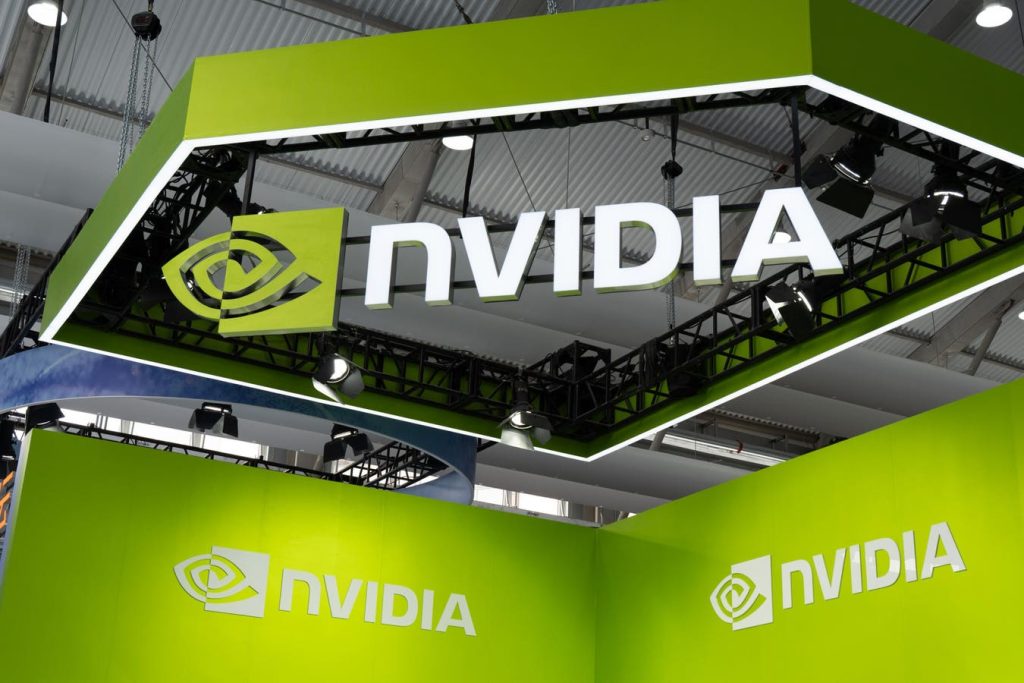SHANGHAI, CHINA – SEPTEMBER 10 2025: The booth of nVidia during a tech show in Shanghai, China Wednesday, Sept. 10, 2025. (Photo credit should read WANG GANG / Feature China/Future Publishing via Getty Images)
Future Publishing via Getty Images
Nvidia’s (NASDAQ: NVDA) supremacy in artificial intelligence accelerators has made it one of the most valuable firms globally, with a market capitalization exceeding $4 trillion. Its financial results have been robust, with revenue climbing 56% compared to the same period last year, reaching $47 billion in the last quarter, and net margins consistently surpassing 50%. However, history serves as a warning. In the world of cryptocurrency, GPUs once held the top position but were ultimately substituted by custom-made ASICs that provided greater efficiency. With Broadcom recently announcing a substantial $10 billion order for its specialized AI chips, reportedly from OpenAI, investors are starting to wonder if AI might follow a comparable path. What could this imply for Nvidia’s long-term future?
Regardless of how fast-growing and enticing, putting money into a single stock entails significant risk. Trefis High Quality Portfolio aims to mitigate stock-specific risk while offering potential upside.
From CPUs to ASICs: The Bitcoin Mining Precedent
When Bitcoin was initially introduced, mining occurred using standard CPUs. Shortly after, miners realized that GPUs were more adept at handling the parallel computations demanded by Bitcoin’s algorithm. Eventually, GPUs emerged as the preferred hardware, only to be later overtaken by FPGAs and eventually ASICs (Application-Specific Integrated Circuits). ASICs introduced a significant transformation. These chips, designed specifically for Bitcoin’s hashing algorithm, provided orders of magnitude more efficiency and speed compared to GPUs. A single ASIC miner could achieve terahashes per second (essentially, the rate at which a machine can execute these guesses), while using considerably less power than setups centered around GPUs.
The downside was specialization: ASICs were limited to mining Bitcoin or similar algorithms, while GPUs could easily transition between different coins or even be adapted for gaming and AI. This led to a complete restructuring of the industry. Mining became capital-intensive and was dominated by large industrial entities capable of investing in extensive ASIC farms. GPUs remain popular among smaller miners, hobbyists, and those mining altcoins that resist ASICs or are tailored for GPU mining.
Could AI Be Next?
Nvidia’s GPUs set the standard for training large language models such as OpenAI’s GPT-4, and they support the majority of the AI infrastructure at hyperscalers. Over the past three years, tens of billions were invested in GPU clusters, driving Nvidia’s swift ascent. For perspective, Amazon (AMZN), Alphabet (GOOG), Microsoft (MSFT), and Meta (META) anticipated spending a combined $364 billion in capital expenditures for their respective fiscal years. However, the economics surrounding AI may also be shifting.
Training large models remains heavily reliant on GPUs, yet this is likely to be a relatively initial-heavy task. As the most readily available data on the Internet is utilized by LLMs (large language models) with diminishing returns from larger models, training growth could moderate somewhat. The majority of future demand is likely to be for inference – executing trained models at scale to respond to billions of queries. In contrast to training, inference is repetitive, reliable, and very sensitive to costs. This is precisely where custom chips could excel, just as ASICs did for Bitcoin. Related: Will Broadcom Chips End AMD Stock’s AI Dreams?
The most compelling indicator emerged last week, when Broadcom announced a $10 billion order for custom AI chips from a singular client, widely thought to be OpenAI. If true, this could imply that OpenAI is relocating a portion of its inference operations away from Nvidia GPUs, likely in pursuit of improved efficiency and reduced costs. Broadcom’s CEO, Hock Tan, has underscored the rise of XPUs or custom accelerators, crafted for specific workloads. These chips could provide hyperscalers with greater control over their infrastructure costs while decreasing reliance on Nvidia’s high-priced GPUs. For OpenAI, whose ChatGPT serves millions of daily users, minor reductions in cost per inference could lead to substantial savings at scale. Having alternatives to Nvidia also enhances bargaining power for GPUs.
Drawbacks of ASICs
The attraction of ASICs in both crypto and AI is evident: efficiency, lower energy consumption, and consistent performance for repetitive tasks. For firms operating AI workloads at large scales, these benefits may prove irresistible. However, there are downsides as well. Once produced, the functionality of an ASIC chip is mainly static, in contrast to GPUs which can be reprogrammed or upgraded. Just as Bitcoin ASICs were confined to the SHA-256 algorithm and vulnerable to protocol alterations, AI-specific chips may not possess the flexibility of GPUs. If AI models rapidly advance or architectures evolve, ASICs could become outdated. On the other hand, GPUs remain extremely adaptable, capable of managing both training and inference across diverse models. The design and manufacturing of custom ASICs is also expensive and time-intensive, potentially making them less accessible to smaller firms.
Implications for Nvidia
For Nvidia, the risk is that its central growth driver – GPUs for AI – may not be as stable as it appears. While training tasks will likely continue to be dominated by GPUs, as the shift toward custom silicon for inference unfolds, Nvidia might experience a decline in demand. Broadcom’s agreement could signify the first step in a larger trend, as hyperscalers like Google, Amazon, and Meta contemplate similar approaches while additionally developing their own chips. Nvidia still benefits from ecosystem advantages and a comprehensive software platform (CUDA) that assists in better securing customer loyalty. Nonetheless, considering the high valuations and strong momentum, the threat posed by ASICs is one that investors should closely monitor.
The Trefis High Quality (HQ) Portfolio, consisting of 30 stocks, has a proven history of comfortably surpassing its benchmarks, which include all three – S&P 500, Russell, and S&P midcap. What accounts for this? Collectively, HQ Portfolio stocks have delivered superior returns with lower risk relative to the benchmark index, providing a smoother ride, as seen in HQ Portfolio performance metrics.


